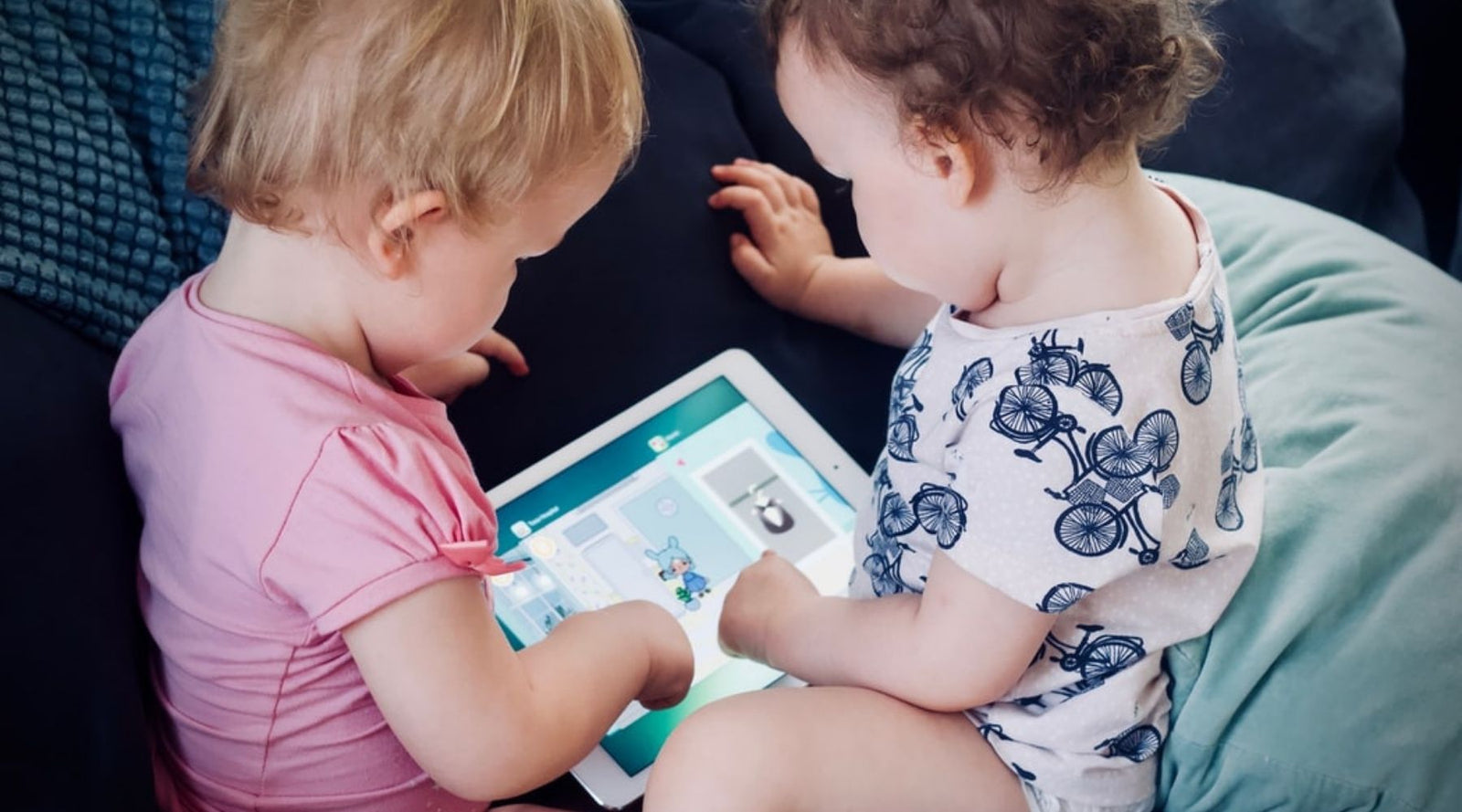Your Cart is Empty
Entire Store TAX-FREE! Clean Beauty Collection SHIPS FREE to most Canadian locations with $90 Order!
Entire Store TAX-FREE! Clean Beauty Collection SHIPS FREE to most Canadian locations with $90 Order!
Protecting Children, Babies and the Unborn from EMF Radiation Harm
May 07, 2021 9 min read

Protecting Children, Babies and the Unborn from EMF Radiation Harm
Children are not little adults and are disproportionately impacted by all environmental exposures, including cell phone radiation. Current FCC standards do not account for the unique vulnerability and use patterns specific to pregnant women and children. It is essential that any new standard for cell phones or other wireless devices be based on protecting the youngest and most vulnerable populations to ensure they are safeguarded throughout their lifetimes.1
American Academy of Pediatrics
More and more children now own cell phones at ever younger ages

A 2019 survey of 1135 US parents with children between the ages of 4 and 14 revealed that:
- 12% of children first use a cell phone between the ages of 1-2!2
- 4 in 10 US kids are 6 or under when they first use a cell phone (40%)
- 65% of pre-teen kids, under the age of 13 own their own phone
- 42% of kids are spending 30+ hours a week on their cell phones!
A 2020 UK survey, based on interviews with 2,200 children in the UK aged five to 16, shows the pivotal place of the mobile phone in young lives.3 Findings include:
- Children are getting mobiles at an earlier age, with most now having their own phone by the age of seven
- The average time spent on mobiles by seven to 16-year-olds is three hours and 20 minutes per day.
- 57% always have the phone beside their bed, including at night when they sleep!
- 44% feel "uncomfortable" if they are ever without a phone signal
- 42% say they keep their phone on them at all times and never turn it off
While there are many other safety factors that parents must consider when their child starts to own a mobile device, in this article we focus on the health risks and actions that can be taken to mitigate these risks.
What makes babies and children so much more at risk to EMF Radiation?
In science and medicine, it is widely accepted that kids are not just “miniature adults.” Children are different on physical, chemical, and biological levels, because their bodies are still developing. This makes them more vulnerable to the damage wireless radiation can cause. Here's why...
Smaller Heads
Children have smaller heads than adults. The radiation goes deeper into their brains because they have a shorter distance from their skull to their brain center. Children's brains absorb more radiation than adult brains4.
Thinner Skulls
The skull actually slows down the radiation. The thicker the skull, the more roadblocks to the radiation moving forward. Since children have much thinner skulls than adults and so they have less protection. Research shows that children absorb up to ten times the radiation in the bone marrow of their skull than adults5.
Rapidly Developing Brain
During childhood the brain is rapidly developing. The brain is not fully myelinated yet, which means they have more water and less fat than adults and are more susceptible to radiation absorption. Disruption of brain development at an early age can cause significant neurological changes later on in life.
Higher Body Water
Children under 12 years of age have higher body water content than adults, which allows them to absorb considerably more radiation.
Total Cumulative Exposure over their Lifetime
Babies, young children and youth of today will be exposed to EMFs for a much longer time than adults today. As a result, the opportunity for them to experience greater mitochondrial damage over time is exponentially higher.
WiFi in Schools
While at first glance, it seems like a good idea, numerous scientists, experts, medical professionals and advocacy groups are becoming vocal about the possible dangers of WiFi in the classroom.
On the surface, it seems like an obvious advantage for making education more modern and convenient. But the underlying health risks must be considered.
Schools are a unique environment because there are so many wireless devices in each room. All wireless devices (including cell phones, laptops, tablets, any item with Wi-Fi or Bluetooth capability, etc.) generate and emit invisible electromagnetic radiation called radiofrequency (RFR).
When a student uses a laptop or tablet in the classroom, the device connects to the Internet via routers or access points and transmits data packets over this signal. Within the confines of the classroom, there can be numerous signals saturating a child’s body for up to eight hours a day, everyday, over many years.
“Let’s have a microwave cooking lesson. We can bake a potato in a microwave oven set at 100% power within 6 minutes. If we reduce the power to 50%, it will take twice as long or 12 minutes, to bake the potato. This is called the time-weighted exposure. Now, let’s replace the potatoes with children, and the microwave oven with a school. Students in school are exposed to microwave radiation for 6 hours/day, 5 days/week, for 40 weeks each year. That comes to 1,200 hours a year. After 10 years, they are exposed to 12,000 hours of microwave radiation a year!”6
Unfortunately, with the COVID pandemic and its associated lockdowns, this WiFi exposure is no longer confined to schools. Pandemic-era digital schooling has brought WiFi routers into more homes. Studies show that at the beginning of the pandemic, global WiFi traffic increased by 80% and there was a 70% - 94% increase in WiFi use between 9 am to 5 pm.7
Unless precautions are taken, babies and children’s exposure to EMF radiation may already be at unprecedented levels - constant at 24/7.
Effects of Wireless Radiation and Excessive Screen Time on Children
Prenatal and Postnatal Impact
A study published in 2020 investigated close to 1400 expectant mothers’ cell phone usage during pregnancy and correlated this data to the newborn’s overall birth measures.
Newborns whose mothers used their mobile phones for more than 30 minutes/day were significantly more likely to have a birth score ≤ 10th percentile than those whose mothers used their mobile phones for less than 5 minutes/day.8
Another study concludes that higher-than-ever levels of maternal exposure to electromagnetic fields could be linked to offspring speech problems.9
A Danish study finds thatexposure to cell phones prenatally, and to a lesser degree postnatally, was associated with behavioural problems at age 7 years in children.10
For expecting mothers or expecting mothers-to-be, do check out this brochure published by babysafeproject.org.
ADHD
ADHD is a brain disorder with symptoms that include a pattern of inattention, hyperactive behavior and impulsiveness that interferes with functioning or development.
In a study published in 2018, researchers tracked nearly 2,600 teenagers for two years. Their finding:
Teens who are heavy users of digital devices are twice as likely as infrequent users to show symptoms of attention-deficit/hyperactivity disorder (ADHD).12
Autism
Many researchers have found EMFs to be a key contributor to autism spectrum disorder (ASD). Martin Pall, PhD and Professor Emeritus of Biochemistry, contends that both EMFs and chemicals have roles in causing the autism epidemic but that EMF exposures are the probable major driver of the epidemic.13
Further clues point to a link between autism and EMFs. There is evidence that placing young patients with autism on a low-EMF-exposure program resulted in dramatic improvements in behaviour.14
Childhood Leukemia
It is truly heartbreaking to see children battle cancer. Sadly, there is a well-established link between ELF-EMF exposures (as emitted by power lines) and childhood leukemia, the most common cancer in children. TheBioInitiative Reporthas compiled close to 100 studies providing evidence of the link between EMF exposure and childhood leukemia.15
Sleep Disturbances
A study involving 11,000 US children aged 9-10, revealed that greater screen media use was associated with higher difficulty falling asleep, shorter sleep duration, and poor sleep quality.16 Without sleep, the body can’t restore itself properly, and this shows up in many factors of health, including mental health.
Mental Health
A 2018 Australian study of 1,101 high school students found that kids whose sleep was impaired by night-time mobile phone use were significantly more likely to experience depressed moods, lowered self-esteem and a lowered coping ability.17
In 2017, San Diego State University psychology professor Jean Twenge published a study wherein teens in 8th through 12th grades were surveyed and results were compared to national statistics on adolescent depressive symptoms and suicide rates.
Teens who spent more than three hours a day on screens were 35 percent more likely to have a risk factor for suicide than those who spent one hour or less. When teens spent five or more hours a day on their phones, that risk increased by 71 percent.18
Simple Protective Actions
Babies and children born in this wireless era will be exposed to far more EMF radiation than any other period in human history. As we become more aware of the health risks associated with exposure, especially for babies and young children, there are simple measures we can take to reduce their level of exposure. We cover much more detail and offer additional resources here.
- Do not use a cell phone while an infant is on your lap, and do not carry your cell phone in your baby carrier. Keep a transmitting cell phone or wireless device away from a child’s brain and body.
- If at all possible, refrain from using wireless Baby Monitors. If you do, please choose a Low EMF version, and use it very sparingly, keeping it a good distance from your baby. We recommend use of an EMF meter to gauge safe distance.
- Avoid making cell phone calls when your baby and/or child is in the car with you. Cell phones and streaming tablets and laptops emit higher power radiation during travel because the metal surroundings create radiation hotspots inside the driver and passenger areas of your vehicle.
- Choose with care what toys/devices you allow your children to play with. As wireless technologies get incorporated into children’s toys, not only do your children get exposed to EMFs but there are security and safety issues19 to consider.
- Delay introducing smartphones and/or tablets to young children as long as you possibly can. There is little developmental benefit in introducing these electronic devices in the very early years.
- When you do decide it is time to do so, please teach them how to use the device safely and responsibly.
- Children should not use mobile phones except during an emergency.
- Do not carry a Powered ON mobile phone anywhere near your body, in your pocket, or bra.
- Never put a laptop or tablet on your lap or abdomen.
- Never put the mobile phone next to your ear. Instead use the speakerphone or an air tube headset to keep the phone away from the body.
- Texting is preferable to voice calls.
- Keep all electronic devices out of the bedroom. Because it is during our sleep at night that our bodies regenerate and repair itself, it is important to keep the bedroom as low in EMF as possible.
- Turn the WiFi router off every night before you retire to bed.
- For the harmful EMFs that you cannot avoid, we recommend Somavedic Medic Green Ultra or Somavedic Sky for your home and Somavedic Harmony for your car to harmonize and neutralize the negative effects of EMFs.
A Word to the Wise
Education starts with the parents, grandparents. We do not underestimate the difficulty of changing the cell phone habits of pre-teens and teens, especially in the face of peer pressure. As parents, we have to model appropriate use of our devices.
Children learn best by emulation. Do what I do, not what I say. If they see the adults in their young lives take these simple actions on a daily basis, along with simple reinforcements of behaviour, they too will easily adopt them without question.
References
1 2013 American Academy of Pediatrics (AAP) Letter to FCC Commissioner Mignon Clyburn and FDA Commissioner Margaret Hamburg calling for a review of RF guidelines, https://ehtrust.org/wp-content/uploads/7520941318.pdf
2 https://www.sellcell.com/blog/kids-cell-phone-use-survey-2019/
3 https://www.bbc.com/news/education-51296197;
http://www.childwise.co.uk/uploads/3/1/6/5/31656353/childwise_press_release_-_monitor_2020_-_immediate_release.pdf
4 B. Mohammed, J. Jin, A. M. Abbosh, K. S. Bialkowski, M. Manoufali and S. Crozier, "Evaluation of Children’s Exposure to Electromagnetic Fields of Mobile Phones Using Age-Specific Head Models With Age-Dependent Dielectric Properties," in IEEE Access, vol. 5, pp. 27345-27353, 2017, doi: 10.1109/ACCESS.2017.2767074. https://ieeexplore.ieee.org/stamp/stamp.jsp?tp=&arnumber=8086149
5 Om Gandhi et al, “Exposure limits: the underestimation of absorbed cell phone radiation, especially in children”,Electromagn Biol Med.2012 Mar;31(1):34-51. doi:10.3109/15368378.2011.622827, https://pubmed.ncbi.nlm.nih.gov/21999884/
6 Dr. Magda Havas declaration in Morrison v. Portland Public Schools: US District Court, District of Oregon, Portland Division, Civil Action No. 3:11. https://ecfsapi.fcc.gov/file/7520958511.pdf
7 “COVID-19 and the Economic Value of WiFi”, https://www.wi-fi.org/download.php?file=/sites/default/files/private/COVID-19_Economic_Value_Wi-Fi_202012.pdf
8 Nathalie Boileau et al, “Mobile phone use during pregnancy: Which association with fetal growth?”, Journal of Gynecology Obstetrics and Human Reproduction, Volume 49, Issue 8, 2020, 101852, ISSN 2468-7847, https://doi.org/10.1016/j.jogoh.2020.101852. https://www.sciencedirect.com/science/article/pii/S2468784720301963.
9 Zarei S, Vahab M, Oryadi-Zanjani MM, Alighanbari N, Mortazavi SM. “Mother's Exposure to Electromagnetic Fields before and during Pregnancy is Associated with Risk of Speech Problems in Offspring”. J Biomed Phys Eng. 2019 Feb 1;9(1):61-68. PMID: 30881935; PMCID: PMC6409372. https://pubmed.ncbi.nlm.nih.gov/30881935/.
10 Divan HA, Kheifets L, Obel C, Olsen J. “Cell phone use and behavioural problems in young children”. J Epidemiol Community Health. 2012 Jun;66(6):524-9. doi: 10.1136/jech.2010.115402. Epub 2010 Dec 7. PMID: 21138897. https://pubmed.ncbi.nlm.nih.gov/21138897/.
11 Madigan S, Browne D, Racine N, Mori C, Tough S. Association Between Screen Time and Children’s Performance on a Developmental Screening Test. JAMA Pediatr. 2019;173(3):244–250. doi:10.1001/jamapediatrics.2018.5056. https://jamanetwork.com/journals/jamapediatrics/fullarticle/2722666.
12 https://news.usc.edu/146032/digital-media-use-linked-to-behavioral-problems-in-kids/
13 https://youtu.be/fJsWkzi14vM
14 http://www.clearlightventures.com/blog/2015/9/11/the-emerging-link-between-wireless-and-autism, https://www.avaate.org/spip.php?article2523
15 https://bioinitiative.org/wp-content/uploads/pdfs/sec12_2012_Evidence_%20Childhood_Cancers.pdf
16 Garrett C. Hisler, Brant P. Hasler, Peter L. Franzen, Duncan B. Clark, Jean M. Twenge, Screen media use and sleep disturbance symptom severity in children, Sleep Health, Volume 6, Issue 6, 2020, Pages 731-742, ISSN 2352-7218, https://doi.org/10.1016/j.sleh.2020.07.002. https://www.sciencedirect.com/science/article/pii/S2352721820301935.
17 Vernon L, Modecki KL, Barber BL. Mobile Phones in the Bedroom: Trajectories of Sleep Habits and Subsequent Adolescent Psychosocial Development. Child Dev. 2018 Jan;89(1):66-77. doi: 10.1111/cdev.12836. Epub 2017 May 29. PMID: 28556891. https://pubmed.ncbi.nlm.nih.gov/28556891/.
18 Twenge, J. M., Joiner, T. E., Rogers, M. L., & Martin, G. N. (2018). Increases in depressive symptoms, suicide-related outcomes, and suicide rates among U.S. adolescents after 2010 and links to increased new media screen time. Clinical Psychological Science, 6(1), 3–17. https://doi.org/10.1177/2167702617723376.
19 https://theconversation.com/4-ways-internet-of-things-toys-endanger-children-94092
Recommended Products
Also in EMF Articles

EMF Blockers vs EMF Harmonizers - What is the Difference?
April 14, 2022 2 min read
Is one better than the other?
Read More
Personal EMF Protection - Is this Necessary?
April 12, 2022 3 min read
Learn key sources EMFs when out and about in town.
Read More
Top 20 Sources of Home EMFs
April 08, 2022 2 min read
Our home EMF exposure continues to grow daily. This list might surprise you!
Read More







